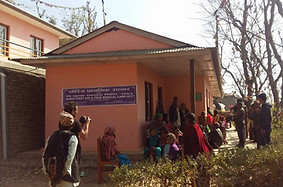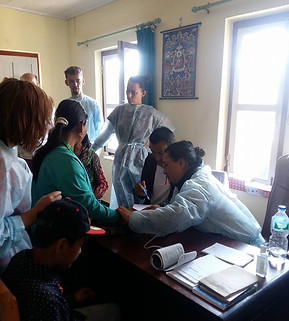
Halesi Dispensary (Nepal)
The Maratika Health Care Center opened in November 2014. This structure is essential for the population of the surroundings who did not have a regular health care system. Doctors and nurses work there on a voluntary basis. Thanks to donations, the dispensary can provide care and medication. It does not receive any state subsidy.

For the local population, but also the many pilgrims who go to this village to visit the sacred site of Maratika.
Traditional Tibetan medicine rubs shoulders with Western medicine according to the needs of patients. It also manufactures treatments, with ancestral recipes, based on local medicinal herbs.

Traditional Tibetan medicine , centuries old, has its roots in Ayurvedic medicine and traditional Chinese medicine. It is called Sowa Rigpa or Sorig; combination of the words gsor ba , meaning "to flourish" and rigs pa meaning "knowledge" or "science", thus designating what is suitable for full development. It aims to balance the health of body and mind.
Traditional Tibetan medicine is still practiced in Central Asia, especially in Ladhak, Tibet and Nepal and more particularly in the remote and isolated villages of the Himalayas which do not have any medical structure.
It is based on the Gyü Shi, a reference text called “The Four Tantras of Medicine”, which contains all the knowledge on the subject and which was transcribed by Yuthock Yonten in the 12th century. This work is still used today by students of traditional Tibetan medicine.


This medicine is based on Buddhist cosmology where everything is made up of 5 elements: space, wind, fire, water and earth symbolizing emptiness, movement, heat, liquid and solid.
The amchi, the doctor who practices traditional Tibetan medicine, examines the balance of the body through the five elements and diagnostic typology of a person based on three moods: Lung, Tripa Bekhan (Wind, Bile and Phlegm).
He examines his patient without medical equipment other than his knowledge and senses:
- the examination of the pulse which refers to different organs,
- visual examination of the patient (eyes, skin, ears, tongue, urine...),
- examination of the outer ear for children,
- questions to the patient.

His methods of care are:
-
herbal pills (up to two thousand types of plants and fifty minerals), powders and decoctions,
-
Energy massages and other external therapies,
-
Dietary advice,
-
Behavioral advice (prevention and healthy lifestyle).
It is a preventive medicine in which the hygiene of life holds a preponderant place, in particular the balance in the choice of food, meal times, adapted physical exercises (often specific yogas) ...
Traditional Tibetan Medicine Sowa Rigpa is practiced in hospitals as a complement to western medicine.
The amchi reminds us that the goal of life is to be happy. Traditional Tibetan medicine therefore allows everyone to become more attentive to how their thoughts and behaviors affect their health and happiness.
The quality of the relationship of Tibetan doctors with their patients is widely praised. The principle of compassion being fundamental to Buddhism, it is one of the key precepts of this medicine that we find through the 11 wishes of amchis.






